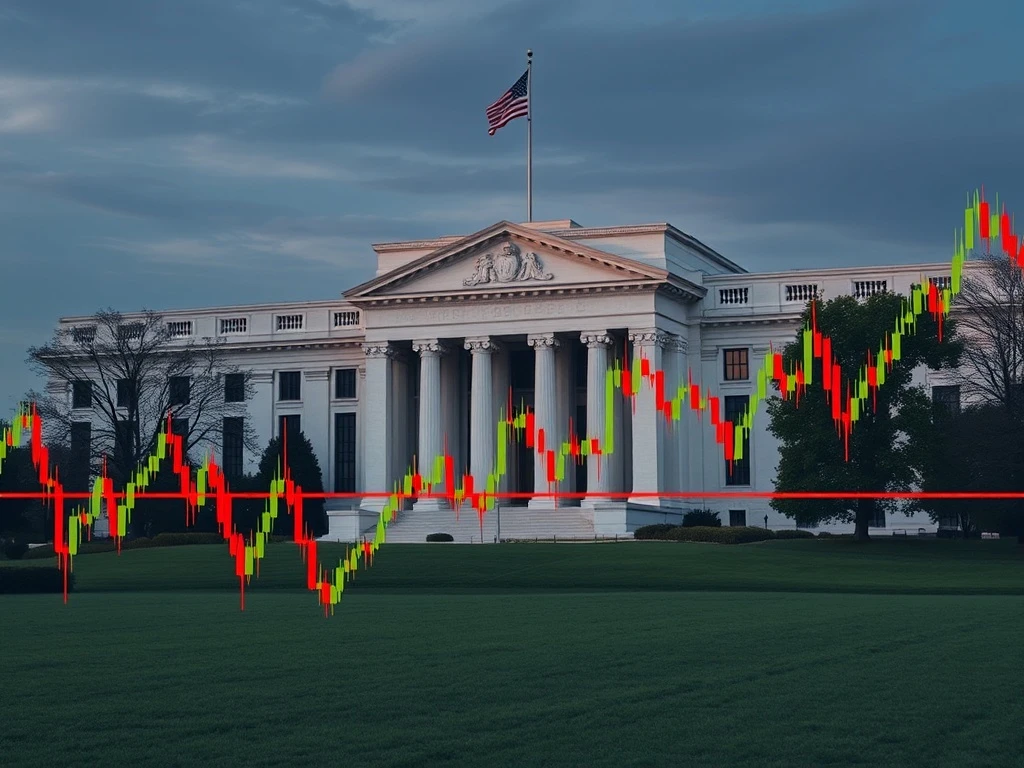Bitcoin’s Shocking Reversal: US Jobs Data Unleashes Uncertainty for Fed Rate Cuts

The crypto world recently witnessed a dramatic turn of events as Bitcoin, the leading cryptocurrency, experienced a swift reversal. After pushing towards the significant $110,000 mark, its upward momentum was abruptly halted. This sudden shift wasn’t a random occurrence; it was a direct reaction to fresh US employment figures that significantly reshaped market expectations regarding the Federal Reserve’s monetary policy. For anyone tracking the volatile cryptocurrency landscape, understanding this interplay between macroeconomics and digital assets is absolutely crucial.
Understanding the Shockwaves: Why US Jobs Data Rocked Bitcoin
The latest release of US nonfarm payrolls data sent immediate ripples across financial markets, including the crypto market. Far exceeding economists’ expectations, the report revealed a robust addition of jobs in June, coupled with a surprising drop in unemployment. This ‘very hot’ jobs report painted a picture of a stronger-than-anticipated US economy, a scenario that typically leads to reduced pressure on the Federal Reserve to stimulate growth through interest rate cuts.
To put it into perspective, the May jobs number was even revised upwards, reinforcing the narrative of a resilient labor market. This positive economic news, paradoxically, often spells short-term challenges for risk assets like Bitcoin. Why? Because a strong economy reduces the urgency for the Fed to lower interest rates, which directly impacts the liquidity and investment appetite in speculative markets.
The Fed’s Stance: Are Fed Rate Cuts Truly Off the Table?
Following the robust employment data, market sentiment quickly pivoted on the likelihood of Fed rate cuts. Before the report, there was a glimmer of hope for a rate reduction as early as July, partly fueled by a preceding private-sector jobs report that painted a different picture. However, the nonfarm payrolls data effectively quashed these expectations. Analysts and market observers, including business consulting firm Blacknox, swiftly concluded that a July rate cut was now ‘off the table.’
The CME Group’s FedWatch Tool, a widely used barometer for gauging market expectations of Fed policy, reinforced this view. It showed a significant reduction in the probability of a rate cut before the Federal Reserve’s September meeting. This means that investors are now largely pricing in a scenario where the Fed maintains higher interest rates for a longer period, with some forecasts suggesting only two cuts in total until December 2025. Such a hawkish outlook from the Fed can dampen enthusiasm for growth-sensitive assets, including cryptocurrencies.
Navigating Volatility: What’s Next for BTC Price?
In the immediate aftermath of the jobs report, BTC price experienced a rapid retracement, shedding much of the gains it had accumulated earlier in the day. Despite this knee-jerk reaction, market analysts offered a more nuanced perspective. Keith Alan, co-founder of Material Indicators, suggested that while the initial price dip was expected, a stronger US economy could be beneficial for the market in the long run. His reasoning is that a robust economy provides a more stable foundation for sustained growth, which eventually trickles down to all asset classes, including digital ones.
From a technical standpoint, the market structure for Bitcoin on shorter timeframes largely remained intact. Key liquidity levels on exchange order books, both above and below the current price, held firm. For traders, the $108,000 level emerged as a critical support zone. Maintaining price above this level is deemed essential for any renewed upside momentum. Should Bitcoin successfully hold $108K, targets of $112,000, and even $120,000, remain on the horizon, signaling that while the immediate reaction was negative, the underlying market structure still holds potential for recovery.
Broader Implications for the Crypto Market and Beyond
The recent volatility in Bitcoin due to US economic data underscores the increasing interconnectedness between traditional financial markets and the digital asset space. While cryptocurrencies were once seen as completely decoupled from mainstream economics, events like strong jobs reports and central bank policy decisions now have undeniable impacts. This means that for participants in the crypto market, keeping a close eye on macroeconomic indicators is no longer optional but a necessity.
The ongoing debate around interest rates and economic growth will continue to shape investor sentiment. As the Federal Reserve navigates its path forward, the crypto market will likely remain sensitive to any shifts in policy expectations. This highlights a key challenge: balancing the inherent volatility of crypto with the broader economic forces at play. However, it also presents an opportunity for informed investors to make strategic decisions based on a comprehensive understanding of both macro trends and on-chain metrics.
Conclusion: A Resilient Path Forward?
Bitcoin’s recent dance with the $110,000 mark, followed by its swift retreat, serves as a powerful reminder of how sensitive the crypto market is to global economic cues. The robust US jobs data, by taking aggressive Fed rate cuts ‘off the table’ for the near future, certainly injected a dose of uncertainty. However, despite the initial shock to BTC price, underlying market structures and some analyst sentiments suggest a degree of resilience. While the path ahead may be volatile, particularly as the market digests future economic reports and Federal Reserve communications, the long-term outlook for Bitcoin remains a subject of ongoing debate and optimism among its proponents. Staying informed and adaptable will be key for navigating these dynamic market conditions.








